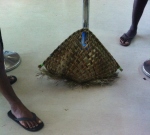I flew from Port Moresby to Kokopo, which is the replacement city to Rabaul, a harbor town destroyed by two volcanoes in 1994 (and 1937). There was once a booming town, now buried under 6 feet of ash, with a busy domestic airport and lots of international tourism, but all there’s left of it is a steamy volcano crater, and 3 or 4 concrete buildings that still need to sweep away ash that gets blown around on a daily basis. Miraculously the town is actually covered in green, the mounds of ask creating the perfect fertile grounds gor a new forest to spring up, and the roads have been excavated to provide access to a few villagers still squatting the modern-day Pompeii, but most of the life has moved 30km away to Kokopo, PNG’s quickest growing city.
The little harbor between Rabaul and Kokopo is basically a chain of volcanoes, 3 which are dormant and 2 which are very active. I had heard of atleast 10 hotels between Rabaul and Kokopo I could stay at, all ludicrously expensive, but after trying my luck at 6 of them which were all full and almost getting killed by a coconut walking out of the Ropopo Resort, I called my friend in Port Moresby to help. He made a few SOS calls, and 2 degrees of separation later, I had the friend of a wife of his friend of his put me up in her cozy apartment in Kokopo. I got attacked by a huge butterfly at the golf club and went to the housewarming party of some aussie, and otherwise most of my time was spent closer to Rabaul, taking in the scenery of a near-Armageddon.
A group of us hiked up a dormant volcano called Mother, which looked down on the dormant Daughter and the active, steam-billowing Tavurvur beside her. We ate coconuts on the way down, the coconut milk, meat, and some weird variation of a seedling coconut whose insides turn into this fluffy cotton candy floss. I spent some time at the market, where the common fare is betel nuts, mustard sticks and lime powder, but also pineapples, cucumbers, tomatoes, peanuts, lettuce, eggplant, avocado if you’re lucky, and some very colourful hand-woven purses.
They were made of palm leaves and yarn, and no matter what shape size or colour, they all ended in frilly bits and unkept ties, slightly resembling ths feathers-on-a-stick charms called “fascinators” that they sell, all to resemble the most beautiful birds and flowers found in nature. The man-purse was taken to a whole new level, since men had just as colourful handbags, but hung them around their necks in an attempt to make them more masculine. But no man went anywhere without his wallet, a woven-leaf basket in a half-moon shape, holding all his most important things (money and betel nuts).


